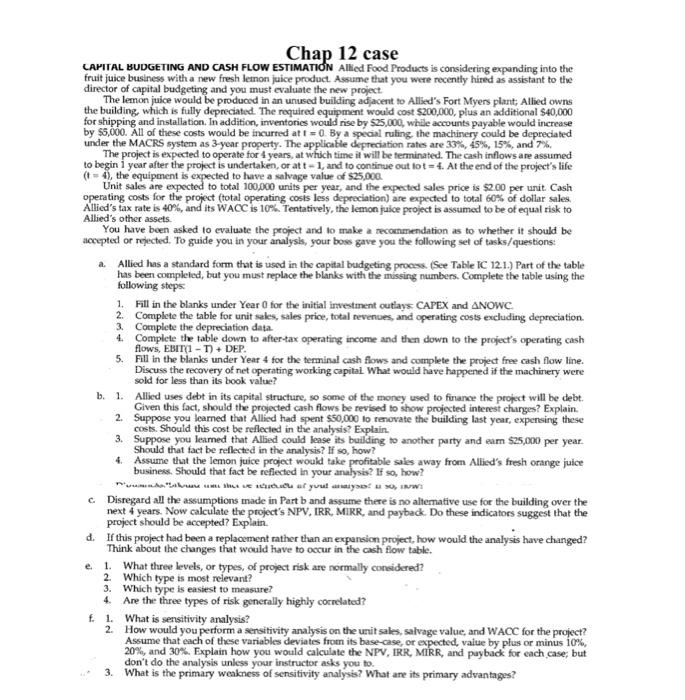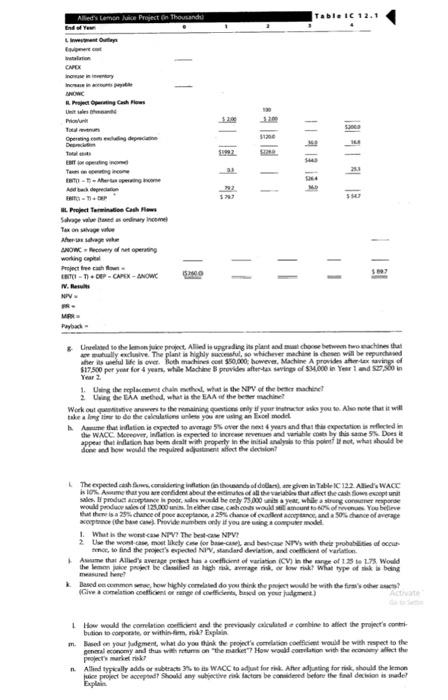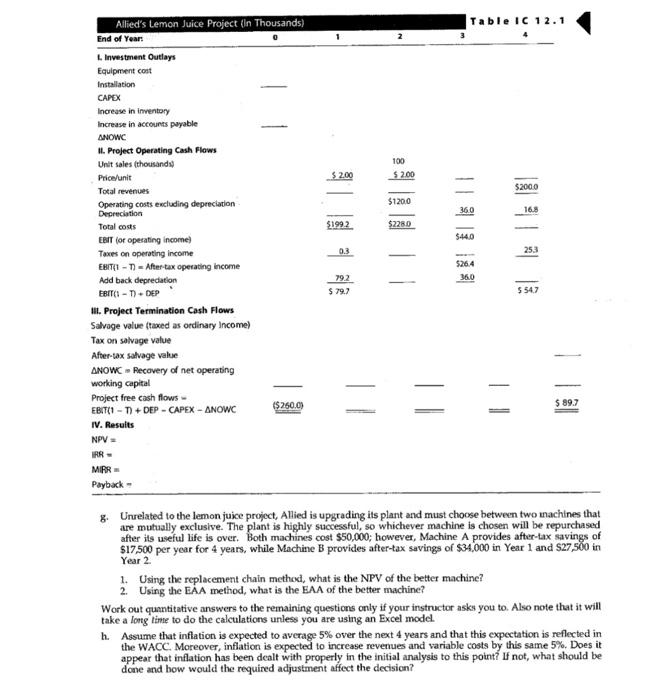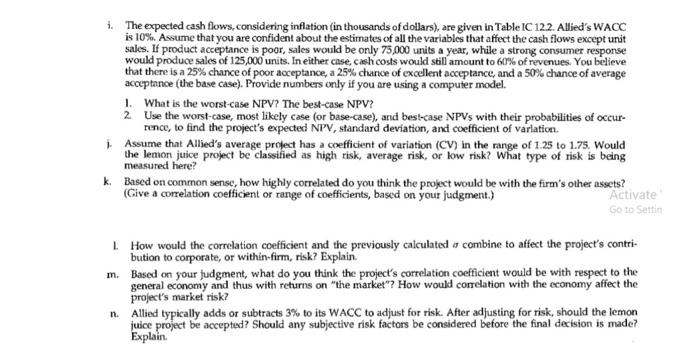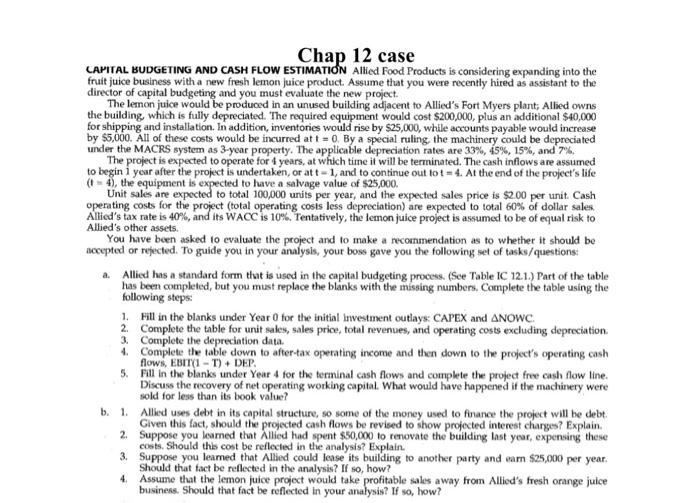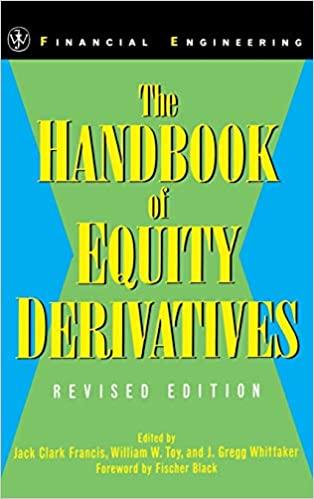Chap 12 case CArITAL BUDGETING AND CASH FLOW ESTIMATION Allied Food Products is considering expanding into the fruit juice bustness with a new fresh lemon juice product. Assume that you were recently hired as assistant to the director of capital budgeting and you must evaluate the new project. The lemon juice would be produced in an unused building adjacent to Allied's Fort Mfyers plant; Albed owns the building, which is fully depreciated. The roquired equipment would cost $200,000, plus an additional $40,000 for shipping and installation. In addition, inventories would rise by $25,000, while accounts payable would increase by $5,000. All of these costs would be tncurted at t=0. By a special ruling. the machinery could be depreciated under the MACRS system as 3-yoar property. The applicable depreciation rates are 33\%, 45\%, 15\%, and 7\%. The project is expected to operate for 4 years, at which time it will be terminated. The cash inflows are assumed to begin 1 year after the project is undertaken, or at t=1, and to consinue out to t=4. At the end of the project's life (t=4), the equipment is expected to have a salvage value of 525,000 . Unit sales are expected to total 100,000 units per year, and the expected sales price is $2.00 per unit. Cash operating costs for the project (total operating cosis less depreciation) are expected to total 60% of dollar sales. Allied's tax rate is 40%, and its WACC is 10%. Tentatively, the lemon jusce project is assumed to be of equal risk to Allied's other assets. You have been asked to evaluate the peoject and to make a reconmendation as to whether it should be accepted or rejected. To guide you in your analysks, your boss gave you the following set of tasks/questions: a. Allied has a standard form that is used in the capital budgeting proces. (See Table lic 12.1.) Part of the table has been compleied, but you must replace the blanks with the mussing numbers. Cocrplete the table using the following steps: 1. Fill in the blanks under Year 0 for the initial investment outiays: CAPEX and NOWC. 2. Complete the table for unit saks, sales price, total revenues, and operating costs excluding depreciation. 3. Complete the depreciation data. 4. Complete the table down to after-tax operating income and then down to the project's operating cash flows, EBIT (11)+ DEP. 5. Fill in the blanks under Year 4 for the terminal cash flows and complete the project free cash flow line. Discuss the recovery of net operating working capital. What wotld have happened if the machinery were sold for less than its book value? b. 1. Allied uses debt in its capital structure, so some of the money used to funance the project will be debt. Given this fact, should the projected cash flows be revised to show projected interest charges? Explain. 2. Suppose you learned that Allied had spent $50,000 to renovate the building last year, expensing these costs. Should this cost be reflected in the analysis? Explain. 3. Suppose you leamed that Albed could lease its building to another party and eam $25,000 per year. Should that fact be reflected in the analysis? If so, how? 4. Assume that the Iemon juice project would take profitable sales away from Allied's fresh orange julce business. Should that fact be reflected in your aralysis? If so, how? c. Disregard all the assumptions made in Part b and assume there is no alternative use for the building over the next 4 years. Now calculate the project's NPV, IRR, MIRR, and payback. Do these indicators suggest that the project should be accepted? Explain. d. If this project had been a replacement rather than an expansion project, how would the analysis have changed? Think about the changes that would have to occur in the cash flow table. e. 1. What threw levels, or types, of project risk are normally coneidered? 2. Which type is most relevant? 3. Which type is easiest to measure? 4. Are the three types of risk generally highly cocrelated? f. 1. What is sensitivity analysis? 2. How would you perform a sensitivity analysis on the unit sales, salvage value, and WACC for the project? Assume that each of these variables deviates from its base-case, or expected, value by plus or minus 10%, 20%, and 30%. Explain how you would calculate the NPV, IRR, MIRR, and payback for each case; but don't do the analysis unless your instructor asks you to. 3. What is the primary wealeness of sensitivity analysts? What are its primary advantages? Year 2. appeat that indaskon has beet dealt with groperty in the intial andyis to this point If not, what should te done and leow wosdd the mquired adpostivent attext the dextsiont 1. What is the wont cale NirVe The best-cave NPV? measurel hese? g. Unrelated to the lemon juice project, Allied is upgrading its plant and must choose between two tnachines that are mutually exclusive. The plant is highly successful, so whichever machine is chosen will be repurchased after its useful life is over. Both machines cost $50,000; however, Machine A provides after-tax savings of $17,500 per year for 4 years, while Machine B provides after-tax savings of $34,000 in Year 1 and $27,500 in Year 2. 1. Using the replacement chain method, what is the NPV of the better machine? 2. Using the EAA method, what is the EAA of the better machine? Work out quantitative answers to the remaining questions only if your instructor asks you to. Also note that it will take a long tine to do the calculations unless you are using an Excel model. h. Assume that inflation is expected to average 5% over the next 4 years and that this expectation is reflected in the WACC. Moreover, inflation is expected to increase revenues and variable costs by this same 5%. Does it appear that inflation has been dealt with properly in the initial analysis to this point? If not, what should be done and bow would the required adjustment affect the decision? i. The expected cash flows, considering inflation (in thousands of dollars), are given in Table IC 12.2. Allied's WACC is 10%. Assume that you are confident about the estimates of all the variables that affect the cash flows except unit sales. If product acceptance is poor, sales would be only 75,000 units a year, while a strong consumer response would produce sales of 125,000 units. In either case, cash costs would still amount to 61% of revenues. You believe that there is a 25% chance of poor acceptance, a 25% chance of excellent acceptance, and a 50% chance of average acceptance (the base case). Provide numbers only if you are using a computer model. 1. What is the worst-case NPV? The best-case NPV? 2. Use the worst-case, most likely case (or base-case), and best-case NPVs with their probabilities of occurrence, to find the project's expected NPV, standard deviation, and coefficient of varlation. 1. Assume that Allied's average project has a coefficient of variation (CV) in the range of 1.25 to 1.75. Would the lemon juice project be classified as high risk, average risk, or low risk? What type of risk is being measured here? k. Based on common sense, how highly correlated do you think the project would be with the firm's other assets? (Cive a correlation coefficient or range of coefficients, based on your judgment.) 1. How would the correlation coefficient and the previously calculated a combine to affect the project's contribution to corporate, or within-firm, risk? Explain. m. Based on your judgment, what do you think the project's correlation coefficient would be with respect to the general economy and thus with returns on "the market"? How would conrelation with the economy affect the project's market risk? n. Allied typically adds or subtracts 3% to its WACC to adjust for risk. After adjusting for risk, should the lemon juice project be accepted? Should any subjective risk factors be considered before the final decision is made? Explain. CAPITAL BUDGETING AND CASH FLOW ESTIMATION AIlied Food Products is considering expanding into the fruit juice business with a new fresh lemon juice product. Assume that you were recently hired as assistant to the director of capital budgeting and you must evaluate the new project. The lemon juice would be produced in an unused building adjacent to Allied's Fort Myers plant; Allied owns the building, which is fully depreciated. The required equipment would cost $200,000, plus an additional $40,000 for shipping and installation. In addition, inventories would rise by $25,000, while accounts payable would increase by $5,000. All of these costs would be incurred at t=0. By a special ruling, the machinery could be depreciated under the MACRS system as 3-year property. The applicable depreciation rates are 33%,45%,15%, and 7%. The project is expected to operate for 4 years, at which time it will be terminated. The cash inflows are assumed to begin 1 year after the project is undertaken, or at t=1, and to continue out to t=4. At the end of the project's life (t=4), the equipment is expected to have a salvage value of $25,000. Unit sales are expected to total 100,000 units per year, and the expected sales price is $2.00 per unit. Cash operating costs for the project (total operating costs less depreciation) are expected to total 60% of dollar sales. Allied's tax rate is 40%, and its WACC is 10%. Tentatively, the lemon juice project is assumed to be of equal risk to Allied's other assets. You have been asked to evaluate the project and to make a recommendation as to whether it should be accepted or rejected. To guide you in your analysis, your boss gave you the following set of tasks/questions: a. Allied has a standard form that is used in the capital budgeting process. (See Table IC 12.1.) Part of the table has been completed, but you must replace the blanks with the missing numbers. Complete the table using the following steps: 1. Fill in the blanks under Year 0 for the initial investment outlays: CAPEX and NOWC. 2. Complete the table for unit sales, sales price, total revenues, and operating costs excluding depreciation. 3. Complete the depreciation data. 4. Complete the table down to after-tax opetating income and then down to the project's operating cash 5. Flows, EBrr(1 - T) + DEP. 5. Fill in the blanks under Year 4 for the terminal cash flows and complete the project free cash flow line. Discuss the recovery of net operating working capital. What would have happened if the machinery were sold for less than its book value? b. 1. Allied uses debt in its capital structure, so some of the money used to finance the project will be debt. Given this fact, should the projected cash flows be revised to show projected interest charges? Explain. 2. Suppose you leamed that Allied had spent $50,000 to renovate the building last year, expensaing these costs. Should this cost be reflected in the analysis? Explain. 3. Suppose you leamed that Allied could lease its building to another party and eam $25,000 per year. Should that fact be reflected in the analysis? If so, how? 4. Assume that the lemon juice project would take profitable sales away from Allied's fresh orange juice business. Should that fact be reflected in your analysis? If so, how? c. Disregard all the assumptions made in Part b and assume there is no altemative use for the building over the next 4 years. Now calculate the project's NPV, IRR, MIRR, and payback. Do these indicators suggest that the project should be accepted? Explain. d. If this project had been a replacement rather than an expansion project, how would the analysis have changed? Think about the changes that would have to occur in the cash flow table. e. 1. What three levels, or types, of project risk are normally considered? 2. Which type is most relevant? 3. Which type is easiest to measure? 4. Are the three types of risk generally highly correlated? f. 1. What is sersitivity analysis? 2. How would you perform a sensitivity analysis on the unit sales, salvage value, and WACC for the project? Assume that each of these variables deviates from its base-case, or expected, value by plus or minus 10%, 20%, and 30%. Explain how you would calculate the NPV, IRR, MIRR, and payback for each case; but don't do the analysis unless your instructor asks you to. 3. What is the primary weakness of sensitivity analysis? What ane its primary advantages? Chap 12 case CArITAL BUDGETING AND CASH FLOW ESTIMATION Allied Food Products is considering expanding into the fruit juice bustness with a new fresh lemon juice product. Assume that you were recently hired as assistant to the director of capital budgeting and you must evaluate the new project. The lemon juice would be produced in an unused building adjacent to Allied's Fort Mfyers plant; Albed owns the building, which is fully depreciated. The roquired equipment would cost $200,000, plus an additional $40,000 for shipping and installation. In addition, inventories would rise by $25,000, while accounts payable would increase by $5,000. All of these costs would be tncurted at t=0. By a special ruling. the machinery could be depreciated under the MACRS system as 3-yoar property. The applicable depreciation rates are 33\%, 45\%, 15\%, and 7\%. The project is expected to operate for 4 years, at which time it will be terminated. The cash inflows are assumed to begin 1 year after the project is undertaken, or at t=1, and to consinue out to t=4. At the end of the project's life (t=4), the equipment is expected to have a salvage value of 525,000 . Unit sales are expected to total 100,000 units per year, and the expected sales price is $2.00 per unit. Cash operating costs for the project (total operating cosis less depreciation) are expected to total 60% of dollar sales. Allied's tax rate is 40%, and its WACC is 10%. Tentatively, the lemon jusce project is assumed to be of equal risk to Allied's other assets. You have been asked to evaluate the peoject and to make a reconmendation as to whether it should be accepted or rejected. To guide you in your analysks, your boss gave you the following set of tasks/questions: a. Allied has a standard form that is used in the capital budgeting proces. (See Table lic 12.1.) Part of the table has been compleied, but you must replace the blanks with the mussing numbers. Cocrplete the table using the following steps: 1. Fill in the blanks under Year 0 for the initial investment outiays: CAPEX and NOWC. 2. Complete the table for unit saks, sales price, total revenues, and operating costs excluding depreciation. 3. Complete the depreciation data. 4. Complete the table down to after-tax operating income and then down to the project's operating cash flows, EBIT (11)+ DEP. 5. Fill in the blanks under Year 4 for the terminal cash flows and complete the project free cash flow line. Discuss the recovery of net operating working capital. What wotld have happened if the machinery were sold for less than its book value? b. 1. Allied uses debt in its capital structure, so some of the money used to funance the project will be debt. Given this fact, should the projected cash flows be revised to show projected interest charges? Explain. 2. Suppose you learned that Allied had spent $50,000 to renovate the building last year, expensing these costs. Should this cost be reflected in the analysis? Explain. 3. Suppose you leamed that Albed could lease its building to another party and eam $25,000 per year. Should that fact be reflected in the analysis? If so, how? 4. Assume that the Iemon juice project would take profitable sales away from Allied's fresh orange julce business. Should that fact be reflected in your aralysis? If so, how? c. Disregard all the assumptions made in Part b and assume there is no alternative use for the building over the next 4 years. Now calculate the project's NPV, IRR, MIRR, and payback. Do these indicators suggest that the project should be accepted? Explain. d. If this project had been a replacement rather than an expansion project, how would the analysis have changed? Think about the changes that would have to occur in the cash flow table. e. 1. What threw levels, or types, of project risk are normally coneidered? 2. Which type is most relevant? 3. Which type is easiest to measure? 4. Are the three types of risk generally highly cocrelated? f. 1. What is sensitivity analysis? 2. How would you perform a sensitivity analysis on the unit sales, salvage value, and WACC for the project? Assume that each of these variables deviates from its base-case, or expected, value by plus or minus 10%, 20%, and 30%. Explain how you would calculate the NPV, IRR, MIRR, and payback for each case; but don't do the analysis unless your instructor asks you to. 3. What is the primary wealeness of sensitivity analysts? What are its primary advantages? Year 2. appeat that indaskon has beet dealt with groperty in the intial andyis to this point If not, what should te done and leow wosdd the mquired adpostivent attext the dextsiont 1. What is the wont cale NirVe The best-cave NPV? measurel hese? g. Unrelated to the lemon juice project, Allied is upgrading its plant and must choose between two tnachines that are mutually exclusive. The plant is highly successful, so whichever machine is chosen will be repurchased after its useful life is over. Both machines cost $50,000; however, Machine A provides after-tax savings of $17,500 per year for 4 years, while Machine B provides after-tax savings of $34,000 in Year 1 and $27,500 in Year 2. 1. Using the replacement chain method, what is the NPV of the better machine? 2. Using the EAA method, what is the EAA of the better machine? Work out quantitative answers to the remaining questions only if your instructor asks you to. Also note that it will take a long tine to do the calculations unless you are using an Excel model. h. Assume that inflation is expected to average 5% over the next 4 years and that this expectation is reflected in the WACC. Moreover, inflation is expected to increase revenues and variable costs by this same 5%. Does it appear that inflation has been dealt with properly in the initial analysis to this point? If not, what should be done and bow would the required adjustment affect the decision? i. The expected cash flows, considering inflation (in thousands of dollars), are given in Table IC 12.2. Allied's WACC is 10%. Assume that you are confident about the estimates of all the variables that affect the cash flows except unit sales. If product acceptance is poor, sales would be only 75,000 units a year, while a strong consumer response would produce sales of 125,000 units. In either case, cash costs would still amount to 61% of revenues. You believe that there is a 25% chance of poor acceptance, a 25% chance of excellent acceptance, and a 50% chance of average acceptance (the base case). Provide numbers only if you are using a computer model. 1. What is the worst-case NPV? The best-case NPV? 2. Use the worst-case, most likely case (or base-case), and best-case NPVs with their probabilities of occurrence, to find the project's expected NPV, standard deviation, and coefficient of varlation. 1. Assume that Allied's average project has a coefficient of variation (CV) in the range of 1.25 to 1.75. Would the lemon juice project be classified as high risk, average risk, or low risk? What type of risk is being measured here? k. Based on common sense, how highly correlated do you think the project would be with the firm's other assets? (Cive a correlation coefficient or range of coefficients, based on your judgment.) 1. How would the correlation coefficient and the previously calculated a combine to affect the project's contribution to corporate, or within-firm, risk? Explain. m. Based on your judgment, what do you think the project's correlation coefficient would be with respect to the general economy and thus with returns on "the market"? How would conrelation with the economy affect the project's market risk? n. Allied typically adds or subtracts 3% to its WACC to adjust for risk. After adjusting for risk, should the lemon juice project be accepted? Should any subjective risk factors be considered before the final decision is made? Explain. CAPITAL BUDGETING AND CASH FLOW ESTIMATION AIlied Food Products is considering expanding into the fruit juice business with a new fresh lemon juice product. Assume that you were recently hired as assistant to the director of capital budgeting and you must evaluate the new project. The lemon juice would be produced in an unused building adjacent to Allied's Fort Myers plant; Allied owns the building, which is fully depreciated. The required equipment would cost $200,000, plus an additional $40,000 for shipping and installation. In addition, inventories would rise by $25,000, while accounts payable would increase by $5,000. All of these costs would be incurred at t=0. By a special ruling, the machinery could be depreciated under the MACRS system as 3-year property. The applicable depreciation rates are 33%,45%,15%, and 7%. The project is expected to operate for 4 years, at which time it will be terminated. The cash inflows are assumed to begin 1 year after the project is undertaken, or at t=1, and to continue out to t=4. At the end of the project's life (t=4), the equipment is expected to have a salvage value of $25,000. Unit sales are expected to total 100,000 units per year, and the expected sales price is $2.00 per unit. Cash operating costs for the project (total operating costs less depreciation) are expected to total 60% of dollar sales. Allied's tax rate is 40%, and its WACC is 10%. Tentatively, the lemon juice project is assumed to be of equal risk to Allied's other assets. You have been asked to evaluate the project and to make a recommendation as to whether it should be accepted or rejected. To guide you in your analysis, your boss gave you the following set of tasks/questions: a. Allied has a standard form that is used in the capital budgeting process. (See Table IC 12.1.) Part of the table has been completed, but you must replace the blanks with the missing numbers. Complete the table using the following steps: 1. Fill in the blanks under Year 0 for the initial investment outlays: CAPEX and NOWC. 2. Complete the table for unit sales, sales price, total revenues, and operating costs excluding depreciation. 3. Complete the depreciation data. 4. Complete the table down to after-tax opetating income and then down to the project's operating cash 5. Flows, EBrr(1 - T) + DEP. 5. Fill in the blanks under Year 4 for the terminal cash flows and complete the project free cash flow line. Discuss the recovery of net operating working capital. What would have happened if the machinery were sold for less than its book value? b. 1. Allied uses debt in its capital structure, so some of the money used to finance the project will be debt. Given this fact, should the projected cash flows be revised to show projected interest charges? Explain. 2. Suppose you leamed that Allied had spent $50,000 to renovate the building last year, expensaing these costs. Should this cost be reflected in the analysis? Explain. 3. Suppose you leamed that Allied could lease its building to another party and eam $25,000 per year. Should that fact be reflected in the analysis? If so, how? 4. Assume that the lemon juice project would take profitable sales away from Allied's fresh orange juice business. Should that fact be reflected in your analysis? If so, how? c. Disregard all the assumptions made in Part b and assume there is no altemative use for the building over the next 4 years. Now calculate the project's NPV, IRR, MIRR, and payback. Do these indicators suggest that the project should be accepted? Explain. d. If this project had been a replacement rather than an expansion project, how would the analysis have changed? Think about the changes that would have to occur in the cash flow table. e. 1. What three levels, or types, of project risk are normally considered? 2. Which type is most relevant? 3. Which type is easiest to measure? 4. Are the three types of risk generally highly correlated? f. 1. What is sersitivity analysis? 2. How would you perform a sensitivity analysis on the unit sales, salvage value, and WACC for the project? Assume that each of these variables deviates from its base-case, or expected, value by plus or minus 10%, 20%, and 30%. Explain how you would calculate the NPV, IRR, MIRR, and payback for each case; but don't do the analysis unless your instructor asks you to. 3. What is the primary weakness of sensitivity analysis? What ane its primary advantages
